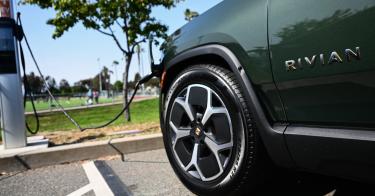Here in Texas oil country, your Uber is more likely to be a pickup than a Prius. Daniel, who works in the oil pipeline business when he’s not driving for Uber, picked me up from Midland International Air & Space Port in his Chevy Silverado. Born in Midland Memorial Hospital and raised in Midland, he showed me the rail tanker cars filled with oil and the Permian Basin Petroleum Museum, a must-see here.
We passed numerous car dealerships on the way to downtown, all seemingly filled with new and used pickup trucks. The stream of dealerships along the highway included Sewell Pre-Owned Sales, Sewell Buick GMC of Midland, and Midland Motors.
“How about those electric vehicles?” I asked Daniel. No one in Midland, it seemed, was interested in an electric vehicle. Midland, as the city describes itself, is where American energy thrives.
People in Midland drive far. On Midland Motors’ used car website, most vehicles had mileage over 200,000, and there were several used pickup trucks for under $10,000.
Midland is a contrast to California, which is moving full-speed ahead with requiring all new vehicle sales to be electric after 2035. Perhaps that’s why 300,000 people left California in 2022, according to the Census Bureau, and many of them came to Texas.
Not only does California want to require that all new vehicles sold in the Golden State are electric by 2035, it also wants all light-duty vehicles and school buses sold there to have “bidirectional charging” by model year 2030. Bidirectional charging means that while your electric vehicle is plugged in to charge, if California needs it, it can take the energy stored in your battery and return it to the electrical grid.
Imagine the surprise when you go to bed thinking your electric pick-up truck will be fully charged for a long-haul business trip the next day, only to find when you wake up that the government has taken your electricity back. When I told this to Daniel in Midland, he said, “That’s crazy!”
Some people think that California’s blackout problems mean that it should not require EVs, as they just drain more power from an already overtaxed grid. But State Sen. Nancy Skinner, D-Berkeley, is sponsoring a bidirectional charging mandate bill because she believes that energy stored in Californians’ batteries will solve the state’s energy shortage.
Skinner said, “The battery capacity in today’s electric vehicles give them the potential to be mini power plants on wheels. That’s crucial as California continues to face unprecedented impacts from climate change, including record heatwaves, wildfires, and destructive storms that can lead to power outages.”
Some vehicles, including the Nissan Leaf, the Hyundai Ioniq 5, and the Ford F-150 Lightning, already have such bidirectional charging systems.
Skinner’s bill has passed the Senate and three committees in the State Assembly. If it passes the State Assembly, Gov. Gavin Newsom will likely sign it into law. Last September, he called the technology a “game changer” and said that “this is the future.”
The bill also includes the ability for the state to require other types of vehicles to have bidirectional charging systems at the discretion of the California Air Resources Board without the passage of a new law. It the state’s power problems are not solved with electricity from cars and school buses, it can draw down electricity from tractors, public transit buses, and trucks.
Carbuzz has calculated that “a 60 kWh EV battery [a typical electric vehicle battery] can provide backup power to the average US household for two to three days.” But that doesn’t absolve the state’s largest power company, Pacific Gas and Electric, of the responsibility to provide power to homes. People should not have to choose between transportation needs, such as going to work or taking someone to the doctor, and keeping their refrigerators and home heating operating.
Bidirectional charging changes the concept of the right to personal mobility and property rights. If EV owners in California must return the electricity in their car batteries to the grid during power shortages, they don’t truly own the energy in their EVs. In essence, the state has the power to tell them when to travel. It also has the power to tell them where to travel, because the state is setting up the network of electric charging stations.
This vast attempt at industrial regulation is meant to reduce global temperatures. But even getting rid of all American fossil fuel emissions would only reduce global temperatures by 0.2 degrees Celsius by 2100, according to government models, because increases in emissions are coming from China, Russia, India, Africa, and Latin America.
Industrial energy policy is not the only reason for the migration from California to Texas. California’s high taxes and high cost of housing are also factors. But the contrast between attitudes about transportation, looked at as a right and a key to the American dream, is stunning and a lesson to other states.
This piece originally appeared in The Daily Signal




